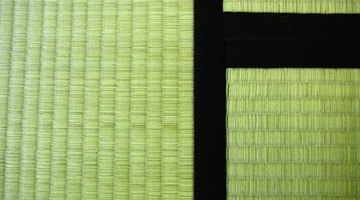Rules for a Tatami Layout
Table of Contents
Tatami mats are traditional Japanese flooring materials, created from rice straw and woven, soft rush straw. The layout of tatami mats in Japanese homes supposedly brings fortune or misfortune, and certain layouts cannot be used in all circumstances.

The rules that govern these layouts are common knowledge to Japanese homemakers, but for those in other countries who use tatami mats, some study and practice is required.
Auspicious and Inauspicious
Tatami mat layouts are said to bring bad or good luck depending on their auspiciousness and the type of ceremony for which they were arranged. An auspicious layout brings good luck, while bad luck is brought by using an auspicious layout inappropriately--during a period of mourning, for instance. Inauspicous layouts aren't necessarily detrimental to your luck.
No Meeting of Three Corners
When arranging tatami mats, three or more corners should never meet at a single point, as it is said this brings misfortune and/or sickness.
No Bisecting Lines
This rule isn't as mystifying as the three-corner rule, but may still be a little odd to those of other nations. Basically, it's a bad idea to have a line that evenly splits the entirety of the layout in two, as this resembles a form of suicide known as a harakiri or seppuku, in which a person stabs their own stomach to die in shame.
One Half Size Tatami Per Room
Tatami mats come in many sizes, such as 3-by-6 foot, 3.15-by-6.3 foot, 2.9-by-5.4 foot and 2.46-by-5.4 foot. Only one half size tatami can be used in any one room. In the case of the above sizes, using any more than one 2.46-by-5.4 tatami per room would bring bad luck.
No Grid Patterns
Arranging the tatami in evenly patterned grids is also said to bring bad luck. The one exception to using the grid pattern is during times of mourning, where it supposedly helps the grief-stricken move on.
Writer Bio
Brian Massey began his professional writing career in 2008. He has published articles relating to technology, health and fitness, and online marketing on various websites. Massey is pursuing a Bachelor of Science in video-game programming at DeVry University.
Photo Credits
- 3 tatami mats (detail) image by koi88 from Fotolia.com
- 3 tatami mats (detail) image by koi88 from Fotolia.com
More Articles



